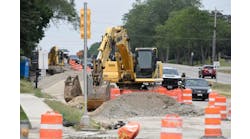The city of Houston is booming, with new construction and development projects happening across the city at an astounding rate.
Texas State Highway 288 (SH 288) is a critical north-south transportation corridor for the greater Houston metro region, and it is under the strain of the region's tremendous growth. Because of this, a section of SH 288 is experiencing severe congestion, resulting in safety issues, and the community needed a solution.
Enter the Texas Department of Transportation’s (TxDOT) latest P3 undertaking—the SH 288 Toll Lanes project. Its essential goal: build capacity on a busy Texas highway to accommodate evacuations and increased growth. Getting there, however, involves a fascinating tale about innovative bridge design and intricate coordination to facilitate standardization.
SH 288 will implement improved functionality over 10.3 miles along SH 288, from U.S. 59 to the Harris/Brazoria County line at Clear Creek, by constructing new toll lanes, installing toll infrastructure, and establishing toll operations and maintenance. The project includes the design, construction, maintenance, and operation of the general-purpose lanes and associated facilities along SH 288, the addition of four tolled lanes within the median of SH 288, eight direct connectors at the Beltway 8 interchange, major interchange work at I-610, direct connectors to Holcombe Boulevard near the Texas Medical Center, and the addition of a future general-purpose lane (per direction) along SH 288 between I-610 and Beltway 8. In all, the project will include 40 new bridges and the rehabilitation of 13 bridges, totaling 1.8 million sq ft of bridge deck and 412 spans.
As a P3 delivery project, the comprehensive project team includes TxDOT as the owner, lead developer Blueridge Transportation Group, lead contractor Almeda-Genoa Constructors, and lead engineer Stantec Consulting Services. The project was awarded to the team in February 2015, and design was substantially completed in June 2017. This $815 million construction project was designed in just under 13 months, substantially faster than traditional roadway/bridge design projects. To meet this aggressive schedule, the engineering team completed preliminary grading, drainage and bridge substructure designs several months prior to the start of construction so the contractor could begin the earthwork and subsurface construction. They also created 14 separate bridge design teams to function simultaneously so they could share best practices and bridge design standards. And finally, they created a great contractor partner who collaborated on value-engineering efforts during the schematic refinement phase to limit large-scale changes during the design/production phase.
The 10-mile-long SH 288 project has been divided into six segments.
Ingenuity in the design
The 10-mile-long project is divided into six segments (as seen in the graphic above). Of note, the proposed I-610 interchange (in green) will replace the current four-level interchange with a new four-level interchange that provides full access from both the new SH 288 toll lanes and the existing SH 288 general-purpose lanes to I-610. The team also is using this same approach at the Beltway 8 interchange (in red).
Site constraints and economic factors posed initial challenges. The new toll lanes had to be constructed in the middle of the existing general-purpose lanes without compromising flexible access and egress for drivers in these managed lanes. Then the idea hit—what if they placed the toll lanes at grade at the I-610 interchange, which had previously called for the proposed toll lanes to be elevated above the existing four-level interchange at I-610, creating a fifth level comprised of two independent toll-lane structures (two travel lanes NB and two travel lanes SB).
By providing at-grade toll access, the team could eliminate fifth-level flyovers at I-610, lowering maintenance costs, reducing risk and minimizing impacts to adjacent properties. Moreover, at-grade access allows commuters to choose whether to enter the toll lanes or the general purposes before entering the highway. This added flexibility increases the potential for toll revenue. The solution was simultaneously simple but complex, and would prove to be a game-changer for SH 288. While the approach could be designed within budget, it would require a generous amount of ingenuity.
SH 288 was designed in just under 13 months.
Prefabrication to the rescue
The design calls for precast caps on single column bents. Rarely used in Texas, the decision to use precast caps is meant to accelerate bridge construction. The caps can be built faster as they are poured and installed off-site. This eliminates the time and infrastructure needed for on-site construction. Using the precast caps meant the difference of days versus weeks in construction time. The precast also provides more flexibility with traffic control by reducing on-site construction traffic.
Thirteen existing bridge structures required modifications—primarily widening. On a typical addition or improvement project, the design team strives to maintain the function and aesthetic of the existing structure. However, at the northern portion of the SH 288 project, several superstructure-type bridges with post tension slabs came under scrutiny due to their dated design. Here, the team chose a more modern solution of box beams and slab beams to widen most of the bridges, an approach that also reduces disruption to traffic during construction. It required innovative engineering (because box beams and slab beams deflect differently than the post tensioned slab) to get the new structure types to work functionally and aesthetically well with the existing structure types.
SH 288 aims to improve functionality of 10.3 miles of roadway.
Coordination is key
Fourteen bridge design teams working in parallel was pivotal to on-time delivery. Early-on, a handful of the structures were identified as essential to the schedule’s critical path. These were established as Priority 1 (P1), while the remainder of the structural design projects fell into Priority 2 (P2). The bridge teams split up work such that each team had some P1 and P2 items so as to not spread one team too thin. The teams also standardized bridge materials and aesthetics to the architectural style prescribed in the TxDOT Green Ribbon Project. The effort, developed by the TxDOT-Houston District, created a blueprint for district engineers and designers to bring continuity to roadway enhancements. It was developed in response to calls from political, civic and other leaders within the Houston community for a more distinct city image.
Because one of the challenges faced when there are multiple design teams is consistency, all the designers employed the same design manuals and guides published by TxDOT. The team also developed a CAD manual that each member followed to further support standardization of overall design themes and graphics.
Construction for SH 288 began in July 2017, and the design team is currently providing construction support services—revisiting the design as construction comes to each segment to make small revisions as required to expedite the construction process. Substantial completion is expected by the summer of 2019, and will bring an easier, safer, and more direct commute to the community that lives, works, and travels on SH 288.



